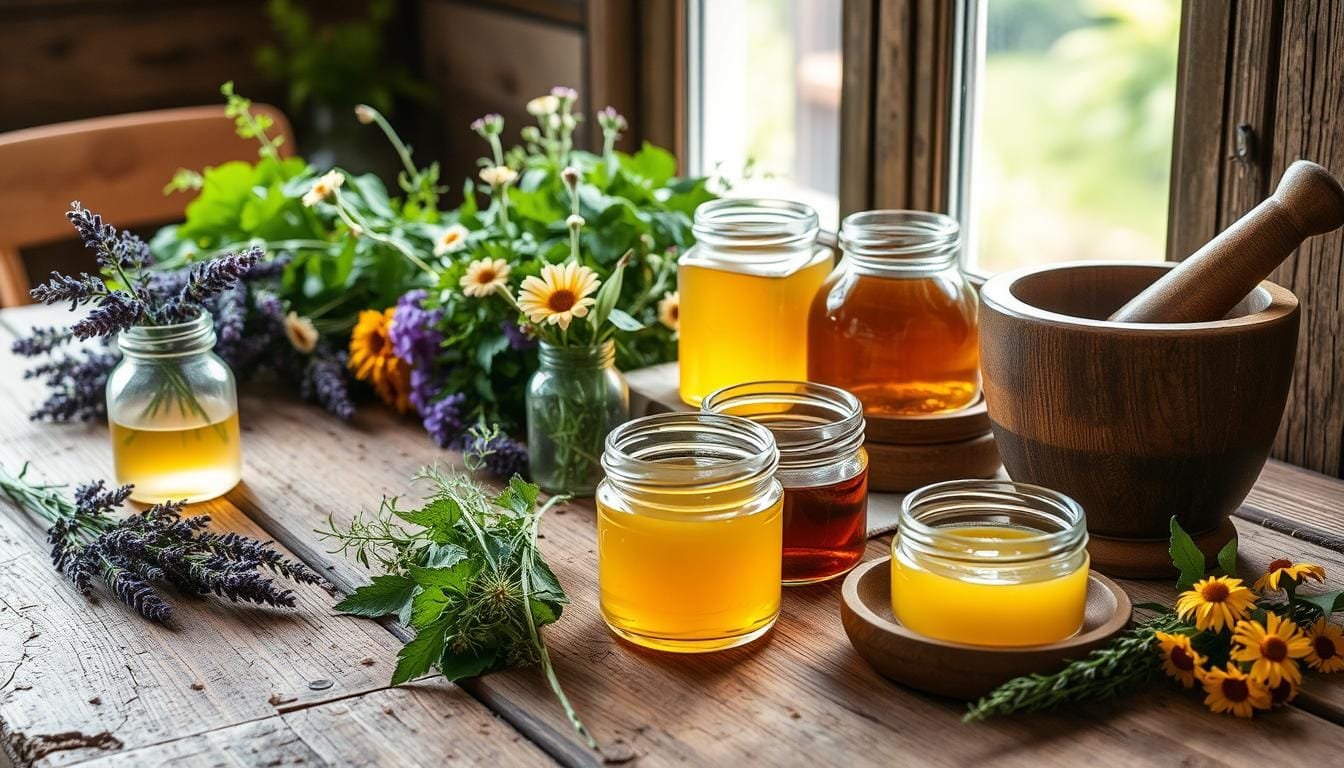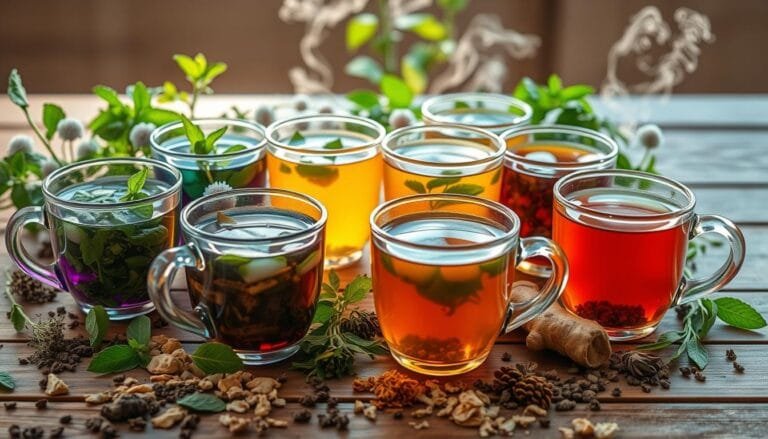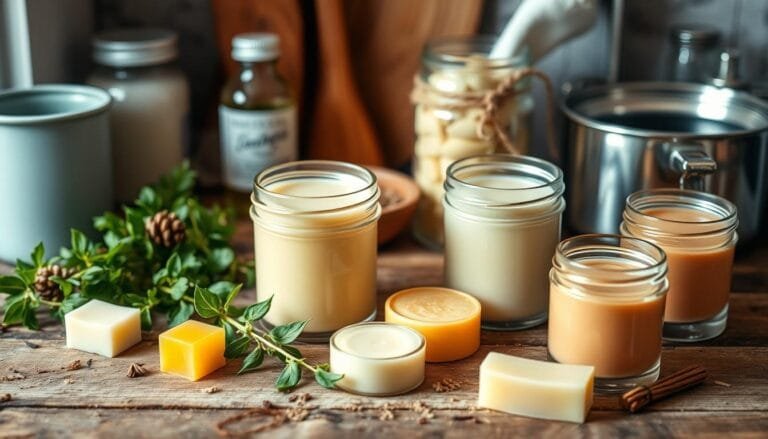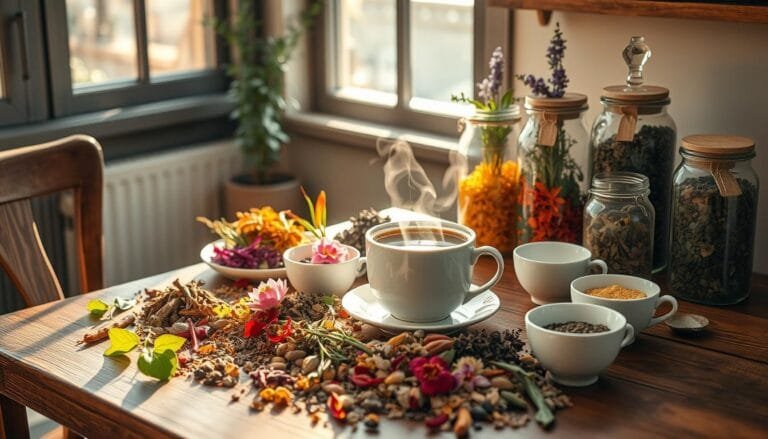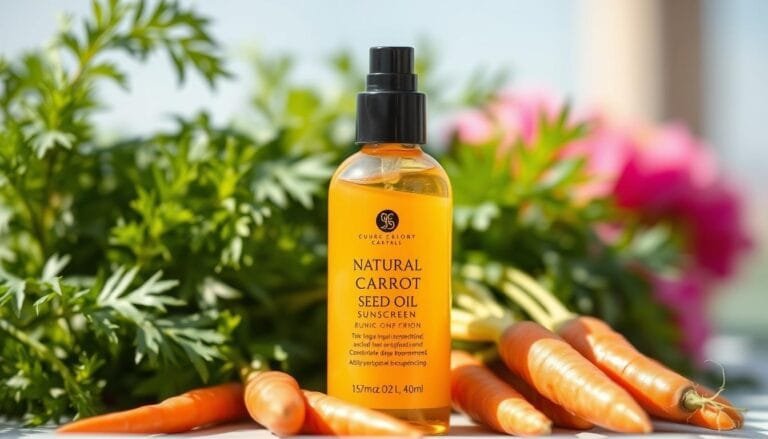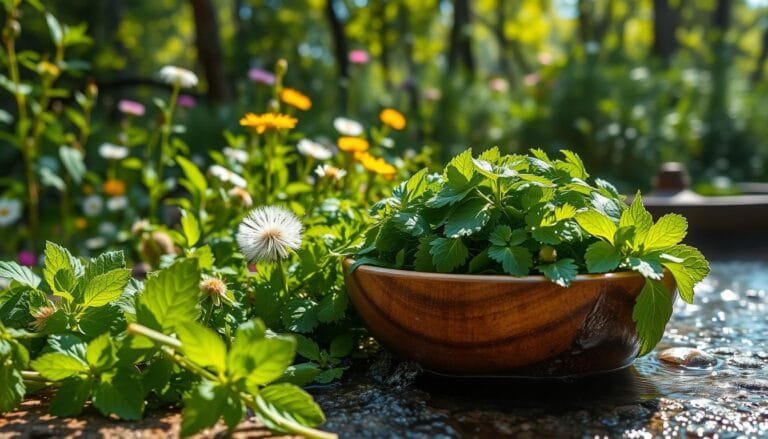As an herbalist, I’ve found the amazing power of natural homemade herbal salves for healing. These ointments, made with medicinal herbs, help with many skin issues. They’re great for minor rashes, wounds, and dry, inflamed skin. Here, I’ll show you how to make your own herbal salves at home.
Herbal salves have been used for ages. They mix plant-based ingredients with oils and beeswax. By using olive, coconut, or sunflower oil with herbs like calendula, comfrey, and plantain, you make a strong natural remedy. These salves help with many skin problems, like cuts, scrapes, muscle aches, and more.
Whether you’re new to herbalism or experienced, making your own herbal salves is rewarding. You’ll learn about the benefits of these remedies and how to make them. This way, you can help yourself and others with a natural, effective way to stay healthy.
Understanding the Power of Herbal Salves for Natural Healing
Herbal salves have been used for centuries in many cultures. They are made from oils and waxes like beeswax. These salves protect the skin and help it absorb nutrients from herbs.
They are popular for natural healing and topical herbal treatments. People use them for skin care and wellness.
What Are Herbal Salves?
Herbal salves are made by mixing herbs into oil, like coconut or olive oil. Then, they add beeswax to the oil. This makes a balm that you can apply to your skin.
Benefits of Using Natural Salves
- Soothe and heal minor scrapes, cuts, and wounds
- Provide relief for itchy, irritated, or dry skin
- Reduce inflammation and alleviate muscle aches and joint pain
- Promote overall skin health and rejuvenation
Traditional Uses Throughout History
Herbal salves have a long history in traditional medicine. They’ve been used for first aid, skin care, and pain relief. Their natural ingredients make them a better choice than commercial products.
“Herbal salves have been used for centuries as natural remedies for various ailments, providing a gentle, yet effective solution for skin and health concerns.”
Essential Ingredients for Making Homemade Herbal Salves
Making homemade herbal salves needs a few key ingredients. At the center are carrier oils, which serve as the base. Olive oil, almond oil, and coconut oil are top picks because they nourish the skin well. Mixing these carrier oils with beeswax is key to getting the right consistency.
Dried herbs are the main attraction, adding lots of good stuff to the salve. Herbs like plantain, comfrey, and calendula are great for soothing and healing the skin. Some recipes might also include essential oils for a nice scent and extra healing benefits.
The usual mix is 1 ounce of beeswax per cup of infused carrier oil. This ratio creates a salve that’s both protective and easy to apply. With the right mix, you can make a salve that’s both versatile and healing.
“Herbal salves are a powerful way to harness the healing properties of nature and nourish your skin from the outside in.”
Best Medicinal Herbs for Healing Salves
When making homemade herbal salves, some plants are better than others. Calendula, comfrey, and plantain are top choices for their healing powers.
Calendula for Skin Soothing
Calendula, or pot marigold, is great for soothing dry, itchy, and red skin. Its bright orange flowers have healing and antimicrobial properties. This makes it perfect for skin salves, helping with rashes, bug bites, and minor irritations.
Comfrey for Wound Healing
Comfrey is a moisturizing herb that speeds up healing for small wounds. It’s rich in allantoin, which helps cells grow back. Its mucilaginous properties also protect the skin.
Plantain for Drawing Properties
Plantain is a gentle herb that soothes bug bites, cuts, scrapes, rashes, and blisters. It’s amazing at pulling out splinters and other small objects from the skin. This makes it a key ingredient in first-aid herbal salves.
Using these medicinal plants in your herb-infused oils lets you make healing salves. These salves can help with skin health and minor issues. Discover the healing power of nature in your homemade remedies!
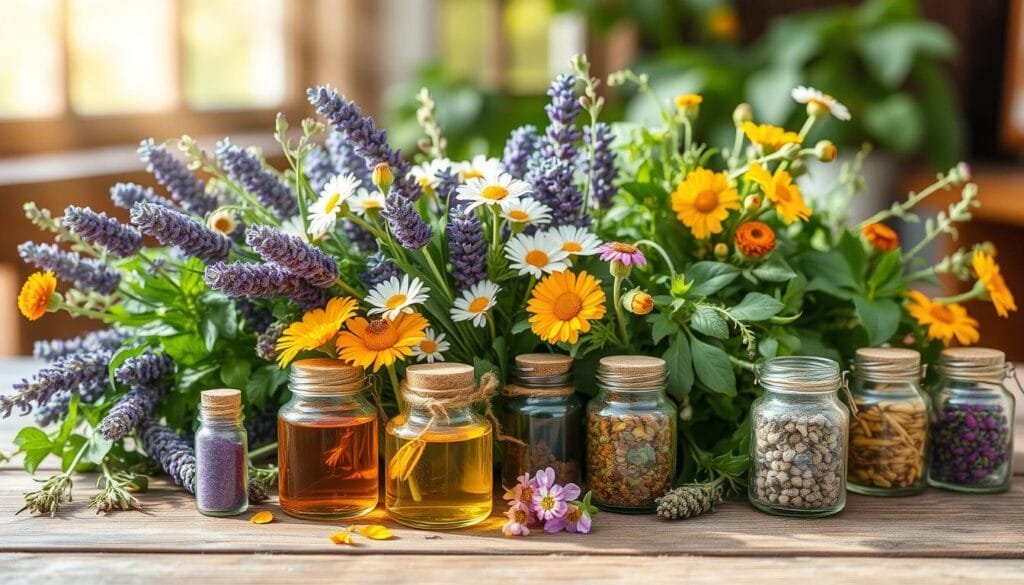
Choosing the Right Carrier Oils and Waxes
When making homemade herbal salves, picking the right carrier oils and waxes is key. The right ingredients can make your salve work better and feel softer on your skin. It’s all about getting the healing and nourishing effects you want.
Olive oil, coconut oil, and almond oil are top picks for salves. Olive oil is loved for its skin-soothing and deep skin penetration. Coconut oil is solid at room temperature and fights off germs. For sensitive skin, almond oil is a gentle choice.
Beeswax is the classic wax for salves, giving them structure and protection. But, for vegan options, soy wax or carnauba wax work just as well.
Finding the right mix of carrier oils and waxes is important for your salve’s texture. Try different ratios to match your skin type and needs.
“Choosing the right carrier oils and waxes is the foundation for creating effective and nourishing herbal salves.”
The quality of your ingredients matters a lot for your homemade salves. Go for high-quality, organic, and cold-pressed oils. This ensures your salves are full of nutrients and good for your skin.
Step-by-Step Guide to Making Homemade Herbal Salves
Making your own herbal salves is rewarding and empowering. It might seem hard at first, but it’s really simple. I’ll show you how to make natural healing salves with herb infusion, beeswax, and essential oils.
Creating the Herb-Infused Oil
To start, mix dried herbs with a carrier oil like olive, coconut, or jojoba in a glass jar. Heat the mix gently in a double boiler or using the double boiler method for 3-5 days. Keep the temperature around 110°F. This lets the herbs infuse into the oil.
Combining Oils with Beeswax
When your herb-infused oil is ready, mix it with beeswax. Melt the beeswax in a double boiler. Slowly add the infused oil, stirring constantly. Use about 1 ounce of beeswax for every 1 cup of oil. Check the texture by freezing a small amount.
Adding Essential Oils
Now, add a few drops of essential oils to your salve. Oils like lavender, tea tree, and frankincense add benefits and scent. Start with 10-20 drops and adjust as needed.
After adding essential oils, pour the salve into containers like tins or jars. Let it cool and solidify before closing the lids. Your homemade DIY salve is now ready to use!

“The overall time required to make a herbal salve is approximately 10 minutes, showing how easy and quick it is.”
Storage and Shelf Life Tips for Natural Salves
Keeping your homemade herbal salves fresh is key to their effectiveness. Storing them properly is essential. Here are some tips to help you keep your handcrafted salves in top condition.
Start by storing your salves in airtight containers like glass jars or metal tins. Place them in a cool, dark spot. This protects the plant oils and keeps the salves fresh for a year or more.
Adding a few drops of vitamin E oil or using essential oils like lavender can also help. These ingredients prevent bacteria and mold, making your salves last longer.
Unlike creams and lotions, salves don’t need refrigeration. Their solid, anhydrous nature makes them more stable. Just avoid direct heat to prevent oil separation.
Labeling your salves is also important. Include the production date, herbs and oils used, and any extra ingredients. This helps you keep track of freshness and use the best salves first.
By following these tips, your natural salves will stay effective for months. Handcrafted with love and stored with care, they’re a valuable part of your natural skincare routine.
Common Applications and Uses for Different Herbal Salves
Herbal salves are natural remedies for many skin and health issues. They can be made at home and are good for first aid, skin care, and pain relief. These salves are gentle yet effective for common problems.
First Aid Applications
Herbal salves are great for first aid. They can help with minor cuts, scrapes, and burns. They also ease insect bites and stings. Herbs like calendula, plantain, and comfrey in these salves promote healing and reduce swelling.
Skin Care Benefits
Herbal salves are also good for your skin. They moisturize and soothe dry, irritated skin. This helps with eczema, dermatitis, and other rashes. Lavender, chamomile, and St. John’s Wort in these salves can fix minor skin problems.
Pain Relief Properties
Herbal salves can also help with pain. Salves with arnica, St. John’s Wort, or cayenne can ease sore muscles and joints. They offer a natural way to manage pain without using harsh drugs.
Homemade herbal salves are versatile and effective for many health issues. They’re great for first aid, skin care, and pain relief. Adding the right herbal salve to your wellness routine can be very helpful.
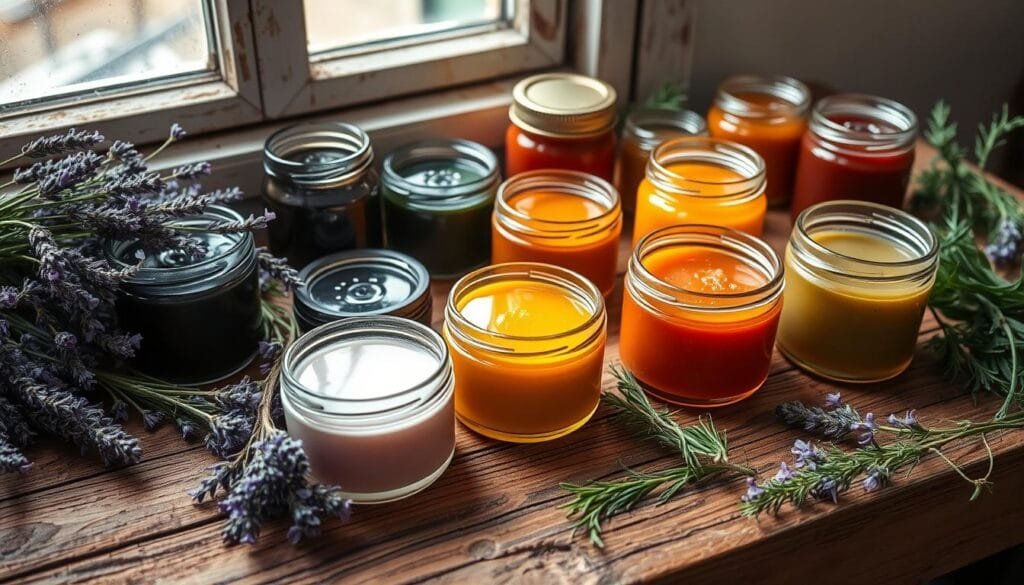
Troubleshooting Common Issues When Making Salves
Making homemade herbal salves can be rewarding but comes with challenges. Knowing common issues and how to fix them is key. Here are some tips to help your salves turn out perfectly every time.
Achieving the Right Salve Consistency
Getting the right consistency in salves is a common concern. If your salve is too hard, try using less beeswax. If it’s too soft, add more beeswax. Start with 10g of beeswax for every 92ml of infused oil.
Preventing Mold Growth
To stop mold in your salves, make sure herbs are dry before infusing them in oil. Any extra moisture can lead to mold. Also, avoid adding water during the making process.
Fixing Separation Issues
If your salve separates, don’t panic. It’s easy to fix. Just reheat it, stirring constantly, until it mixes well again. Once cooled, it should be smooth and consistent.
Always do a patch test before using a new salve on your skin. This is because there’s a chance of allergic reactions. By tackling these common problems, you’ll make great homemade herbal salves that heal and nourish your skin.
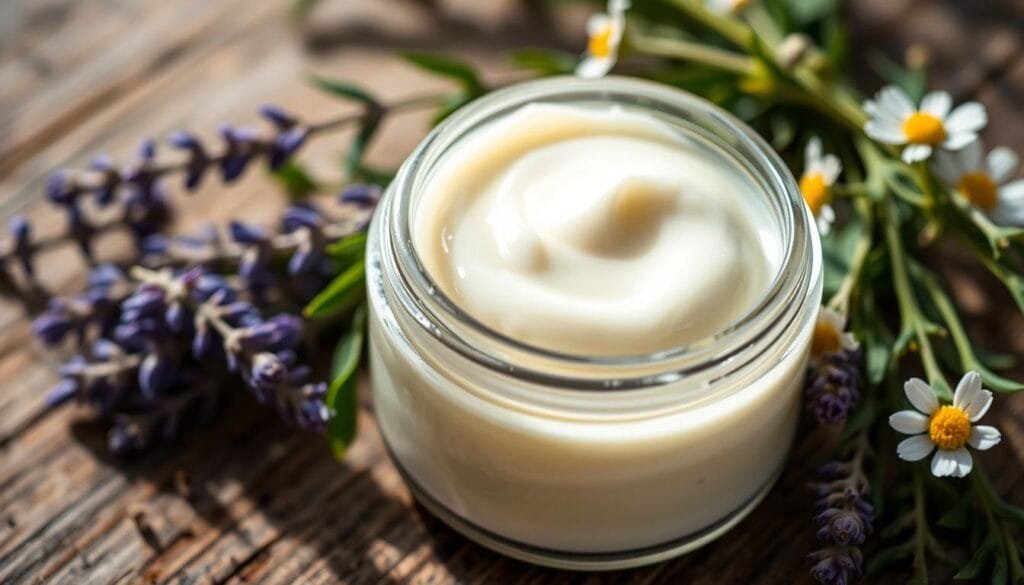
| Ingredient | Ratio for Basic Salve | Ratio for Medicinal Salve | Ratio for Vegan Salve |
|---|---|---|---|
| Infused Oil | 67 ml | 75 – 80 ml | 92 ml |
| Beeswax | 5 g | 10 g | N/A |
| Candelilla Wax | N/A | N/A | 8 g |
| Tincture | N/A | 10 ml | N/A |
| Essential Oils | 1 ml | 2 – 5 ml | 1 ml |
Safety Considerations and Precautions
Exploring homemade herbal salves is exciting, but safety is key. Before using any herbs, I research their effects on skin and how they might interact with my medications. This way, I avoid any possible issues.
I’m careful when using salves on deep or infected wounds. These need extra care, so I check with my doctor first. Pregnant women and those with certain health issues should also talk to their doctor before using herbal products.
To keep my family and pets safe, I store all salves where they can’t get to them. I label each batch with ingredients and the date made. This helps me keep track of how fresh and strong the products are. By focusing on safety and proper use, I can enjoy the natural healing benefits without risking my health.
